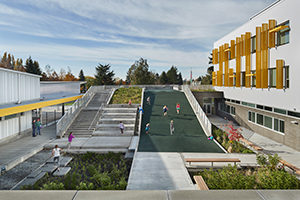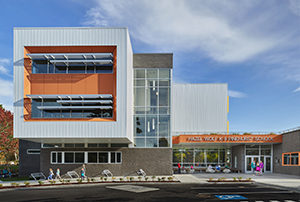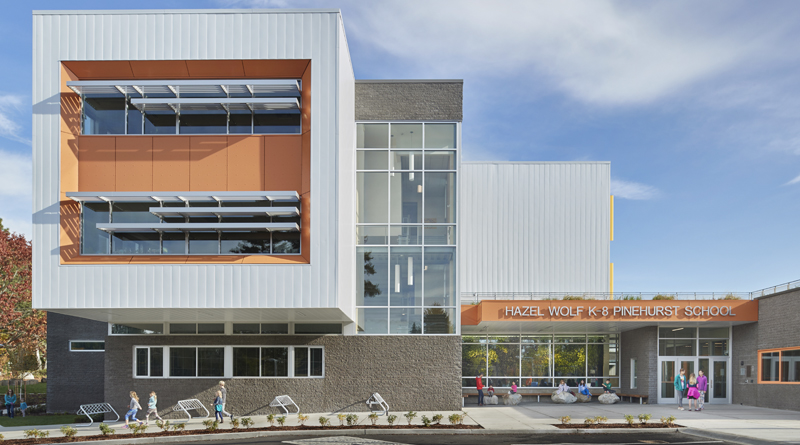Facility of the Month: Hazel Wolf K-8 Embraces Nature
By Jessie Fetterling
A curriculum that emphasizes environmental science set the tone for the design of the new Hazel Wolf K-8 school in Seattle. As an Environmental STEM (E-STEM) school, the urban facility needed a design that not only featured the typical flexible learning spaces seen in most of today’s 21st century schools, but also interior labs, green walls, outdoor learning spaces and gardens for students to get a well-rounded environmental education.

The 83,000-square-foot school was built on a 3.2-acre site in time for the 2016-17 school year. NAC Architecture served as the architect, while Lydig Construction served as the general contractor — both of which have local offices in the Seattle area.
“The main goal was to create a school that was custom made to suit [the district’s] E-STEM program and to do this in a creative way on a small piece of property, giving students good access to outdoors and their natural environment,” said Matt Rumbaugh, principal architect for NAC Architecture.
Embracing Nature
Research continues to show that nature and outdoor lessons enhance learning by triggering the curiosity of young learners. At Hazel Wolf, all subjects are taught through an environmental lens, starting at the kindergarten level. Early learners at the school partake in lessons that include a fallen leaf scavenger hunt, while third to fifth graders learn about the history of native cultures and earthquake analysis. Sixth through eighth graders are taught how to conduct soil filtration tests and practice creative writing while sitting in nature.
“The idea that environmental learning is something the school does on a day-to-day basis influenced the overall feel and layout of the building, and you really feel that when you go to the building,” Rumbaugh said.
The school’s specific lesson plans helped inspire the design for the facility itself, which can accommodate up to 680 students. The building was organized in three parts, with approximately one-third dedicated to outdoor spaces and the rest dedicated to indoor ones. The first part is a three-story academic building where a majority of the classrooms and science labs are located. The central portion includes the main office area, library and art room as well as an outdoor reading area off the library that connects to the central courtyard atop the building. The third section features a cafeteria commons, gymnasium, and music room and stage as well as a preschool space available for a licensed private provider.

Photo Credit (All): Ben Benschneider
A key part of the design is the outdoor courtyard located on the roof of the building’s middle portion. This open-air space features several teaching areas focused on plantings and stormwater management, including a constructed rain garden for students to learn about the water cycle. Here, students can test water samples for pollutants.
“There is also an area in the courtyard where students can see where rainwater comes onto the site, how it’s dealt with, how it’s treated and how long it stays on site,” said Bill Dobyns, vice president of business development for Lydig Construction.
Other outdoor spaces include recreational fields, a butterfly garden and a botanical garden that serves as an outdoor laboratory.
Because the building is so focused on the outdoor environment, the design team addressed security in a couple of ways. First, the building itself wraps around the central courtyard to increase security, with doors and gates that allow the courtyard to be secured throughout the day. Additionally, the butterfly garden was located within the fenced area adjacent to the outdoor space, and students can only access the botanical garden with teacher supervision. Another way the school addresses security is through after-hour key-card access that limits and controls use of the building when classes are not in session.
Following a national trend in school security, the school also features a vestibule for visitors to enter through during school hours. The vestibule includes a camera and a buzzer/intercom system, so school administrators can see and communicate with everyone requesting access to the building before it is given, according to Dobyns.

